

Tower and Town, May 2023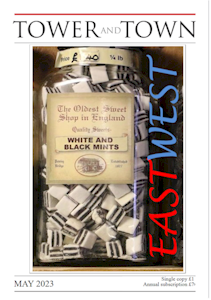 (view the full edition) (view the full edition)Syria: East-West Melting PotI sometimes find it rather hard to believe that my family and I were fortunate enough to travel to Syria in 2010 and visit places such as Aleppo, Deir ez-Zor and Palmyra which have since been destroyed by the Syrian army and/or ISIS. I have chosen six snapshots from the many unforgettable experiences we had which illustrate the theme of East and West in one way or another.  Syria is a country at the crossroads of civilisation - a melting pot of East and West. It has been marched through and meddled with by many different armies and peoples. This was evident from the very beginning of our visit. Arriving at the airport I wondered why it was named after Julia Domna, who, as the wife of the Roman emperor Septimius Severus, had lived in York from 208-211. The reason was, as our Syrian guide told us, that she, along with four other Roman empresses, was Syrian, born in Emesa (now Homs). She was a remarkable woman, educated and powerful and striking in appearance as can be seen from her portrait (photo left) in her elaborate wig. Syria is a country at the crossroads of civilisation - a melting pot of East and West. It has been marched through and meddled with by many different armies and peoples. This was evident from the very beginning of our visit. Arriving at the airport I wondered why it was named after Julia Domna, who, as the wife of the Roman emperor Septimius Severus, had lived in York from 208-211. The reason was, as our Syrian guide told us, that she, along with four other Roman empresses, was Syrian, born in Emesa (now Homs). She was a remarkable woman, educated and powerful and striking in appearance as can be seen from her portrait (photo left) in her elaborate wig.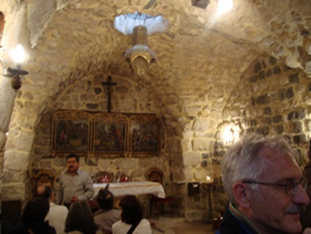 We spent a couple of days in Damascus. We visited St Ananias' House where St Paul stayed, on the "street which is called Straight" [Acts 9:11] situated in the Christian quarter on the eastern side of the Old City among many churches of different denominations. Steeped in bible stories from childhood, my husband and I found this incredibly moving as did the group of Australians visiting at the same time (photo right). As you move westwards into the Muslim quarter the road becomes encroached by a lively covered souk full of every kind of shop most notably selling spices of a myriad of colours and some very racy underwear! The Umayyad mosque afforded our first experience of the interior of a mosque. We were provided with some very unattractive clothing to cover our bare flesh and for the women our hair too. Men in shorts were provided with long skirts! It was worth the ignominy of the awful attire. We spent a couple of days in Damascus. We visited St Ananias' House where St Paul stayed, on the "street which is called Straight" [Acts 9:11] situated in the Christian quarter on the eastern side of the Old City among many churches of different denominations. Steeped in bible stories from childhood, my husband and I found this incredibly moving as did the group of Australians visiting at the same time (photo right). As you move westwards into the Muslim quarter the road becomes encroached by a lively covered souk full of every kind of shop most notably selling spices of a myriad of colours and some very racy underwear! The Umayyad mosque afforded our first experience of the interior of a mosque. We were provided with some very unattractive clothing to cover our bare flesh and for the women our hair too. Men in shorts were provided with long skirts! It was worth the ignominy of the awful attire. 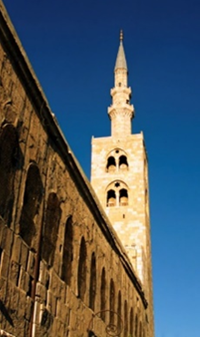 A panoply of wonders met our eyes: beautiful mosaics and patterned marble and a man sleeping with his shoes by his side on the red carpet in the centre of the prayer hall! It was intensely moving to be in this venerable space where Christianity and Islam co-exist. Christian and Muslim tradition alike consider it the burial place of John the Baptist's head while Muslim tradition holds that the mosque will be the place Jesus will return before the End of Days (hence the Isa or Jesus minaret - left). Two shrines inside commemorate John the Baptist and the prophet Muhammad's grandson Husayn ibn Ali, whose martyrdom is frequently compared to that of John the Baptist and Jesus. A panoply of wonders met our eyes: beautiful mosaics and patterned marble and a man sleeping with his shoes by his side on the red carpet in the centre of the prayer hall! It was intensely moving to be in this venerable space where Christianity and Islam co-exist. Christian and Muslim tradition alike consider it the burial place of John the Baptist's head while Muslim tradition holds that the mosque will be the place Jesus will return before the End of Days (hence the Isa or Jesus minaret - left). Two shrines inside commemorate John the Baptist and the prophet Muhammad's grandson Husayn ibn Ali, whose martyrdom is frequently compared to that of John the Baptist and Jesus. 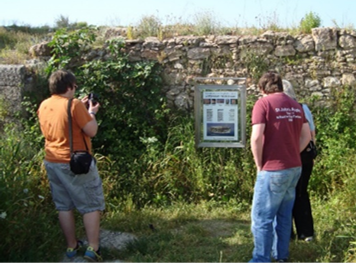 As a linguist I found it thrilling to visit Ugarit (near Latakia in northern Syria). In a very unremarkable room, its crumbling walls overgrown with weeds, clay tablets had been found written in Ugaritic (used from 1400/1300BC). They provide the earliest evidence of both the North Semitic and South Semitic orders of the alphabet, which gave rise to the alphabetic Phoenician writing system and its descendants the Hebrew, Syriac, Greek and Latin alphabets. My son was moved to say "That's really cool, Mum" (photo right).We had our most memorable experience of all in Aleppo. Walking through the back streets we met a girl aged about 7, returning home with her arms out in front of her bent at the elbows across her body carrying several flat, circular loaves of bread, standard fare in Syria. I remember her beaming smile, her bright blue school uniform and her shining black plaits tied with matching ribbons. Turning the corner we found the bakery with its open arch above a counter at which a queue of mostly men was waiting. We were ushered to the front to ensure that, as visitors, we were served first. We were treated with gentle courtesy. I am chilled to think what has happened to all those people, going about their ordinary lives with joy and kindness, when so many inhabitants of Aleppo were killed, injured or displaced during the civil war. As a linguist I found it thrilling to visit Ugarit (near Latakia in northern Syria). In a very unremarkable room, its crumbling walls overgrown with weeds, clay tablets had been found written in Ugaritic (used from 1400/1300BC). They provide the earliest evidence of both the North Semitic and South Semitic orders of the alphabet, which gave rise to the alphabetic Phoenician writing system and its descendants the Hebrew, Syriac, Greek and Latin alphabets. My son was moved to say "That's really cool, Mum" (photo right).We had our most memorable experience of all in Aleppo. Walking through the back streets we met a girl aged about 7, returning home with her arms out in front of her bent at the elbows across her body carrying several flat, circular loaves of bread, standard fare in Syria. I remember her beaming smile, her bright blue school uniform and her shining black plaits tied with matching ribbons. Turning the corner we found the bakery with its open arch above a counter at which a queue of mostly men was waiting. We were ushered to the front to ensure that, as visitors, we were served first. We were treated with gentle courtesy. I am chilled to think what has happened to all those people, going about their ordinary lives with joy and kindness, when so many inhabitants of Aleppo were killed, injured or displaced during the civil war.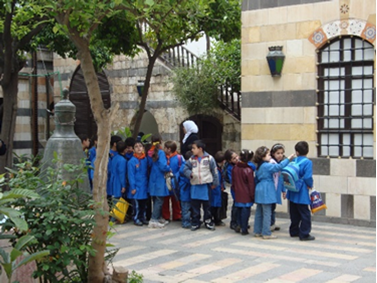 Returning to Damascus we visited the Al-Azm palace (built during the Ottoman era as a residence for the governor of Damascus). The beauty of the interior with its striped masonry, restrained decoration of key features in patterned marble, cascading bougainvillea and elegant trees is well disguised. You enter through a nondescript door and down a long, narrow corridor. It was good to see a group of school children enjoying the space under the quiet but firm direction of their female teachers (photo left). As they all learned English at school they were keen to try out their skills with us; they left waving a cheery goodbye and saying "We love you!" We loved them too. East or west, we respond to each other as beings with a common humanity and I cannot help thinking that the Syrian people deserve far better than the hand they have been dealt. Returning to Damascus we visited the Al-Azm palace (built during the Ottoman era as a residence for the governor of Damascus). The beauty of the interior with its striped masonry, restrained decoration of key features in patterned marble, cascading bougainvillea and elegant trees is well disguised. You enter through a nondescript door and down a long, narrow corridor. It was good to see a group of school children enjoying the space under the quiet but firm direction of their female teachers (photo left). As they all learned English at school they were keen to try out their skills with us; they left waving a cheery goodbye and saying "We love you!" We loved them too. East or west, we respond to each other as beings with a common humanity and I cannot help thinking that the Syrian people deserve far better than the hand they have been dealt. Sarah Bumphrey |